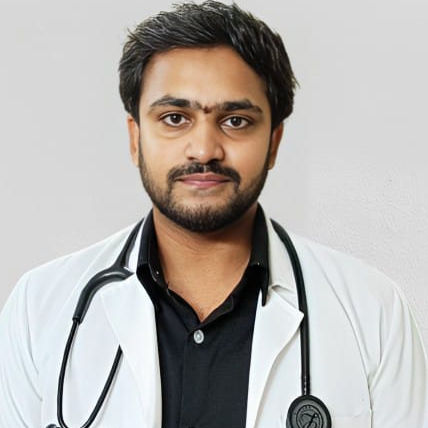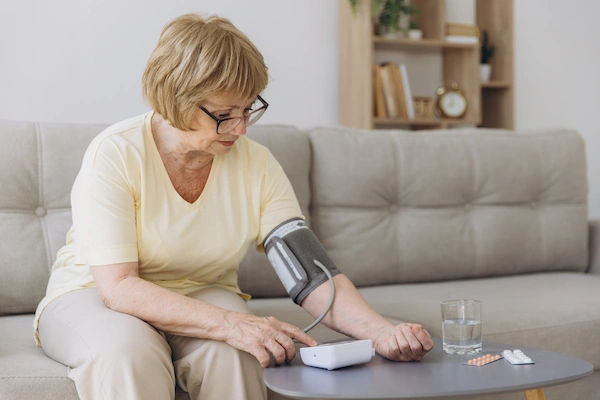Hypertension in Young Adults: A Practical Guide
Discover how to identify, manage, and prevent hypertension in your 20s and 30s. Learn about causes, symptoms, lifestyle strategies, and treatment options. Get a clear 90-day action plan to control blood pressure and protect your long-term health.

Written by Dr. Dhankecha Mayank Dineshbhai
Reviewed by Dr. Rohinipriyanka Pondugula MBBS
Last updated on 29th Oct, 2025
_1.webp?tr=q-80,f-webp,w-350,dpr-2,c-at_max 700w)
Introduction
If you think hypertension is only a problem for older people, think again. Many young adults are discovering elevated readings at routine check-ups, during gym screenings, or on smart home devices. The good news: high blood pressure is highly manageable—and the earlier you act, the more you protect your heart, brain, kidneys, and future health.
This practical guide explains exactly what hypertension means for young adults, how to measure blood pressure correctly at home, when to suspect hidden or secondary causes, and what to do over the next 90 days to bring your numbers down. You’ll learn proven lifestyle strategies, when medications make sense, and how choices around sleep, stress, alcohol, caffeine, and even supplements can shift your readings. We’ll also cover special situations such as birth control, pregnancy, and ADHD medications. Whether your readings are borderline or clearly high, you’ll leave with a step-by-step plan to take control—starting today.
Consult a Top General Practitioner for Personalised Advice
Understanding Hypertension in Your 20s and 30s
This section helps you recognise what counts as high blood pressure, why it happens, and how common it really is among younger adults.
What Counts as High Blood Pressure (Home vs Clinic Numbers)
Doctors diagnose hypertension using clinic readings of 130/80 mm Hg or higher, confirmed on more than one visit and preferably with out-of-office measurements like home blood pressure monitoring (HBPM) or 24-hour ambulatory monitoring (ABPM). Because anxiety can spike numbers in the clinic, many guidelines recommend confirming with ABPM or a week of standardised HBPM before confirming a diagnosis. At home, an average of 130/80 mm Hg or higher generally aligns with clinic thresholds. If your average home readings are elevated (for example, 130–134/80–84), that’s a signal to act early with lifestyle changes and follow-up.
BP Categories and Targets You Should Know
- Normal: <120/80 mm Hg
- Elevated: 120–129/<80 mm Hg
- Stage 1 hypertension: 130–139/80–89 mm Hg
- Stage 2 hypertension: ≥140/90 mm Hg
Targets vary by individual risk, but most young adults aim for <130/80 mm Hg once treated. If symptoms persist beyond two weeks, consult a doctor online with Apollo 24|7 for further evaluation and a personalised plan.
How Common Is Hypertension in Young Adults
Hypertension affects a significant proportion of young people: around one in four adults aged 20–44 meet criteria under modern definitions, and many are undiagnosed or untreated. Early detection matters because invisible damage can begin years before symptoms appear.
Why It Matters Now: Long-Term Risks of Early Hypertension
Early-onset high blood pressure can quietly damage vital organs for years before symptoms appear, making awareness and action critical.
The “Silent” Damage in Your 20s and 30s
High pressure stresses artery walls, accelerates atherosclerosis, and increases the workload on your heart. Over time, this can thicken the heart muscle, reduce kidney function, and increase stroke risk—even in your 30s and 40s. Because hypertension is often symptom-free, routine checks and home monitoring are essential.
Evidence from Cohort Studies
Research shows that even stage 1 hypertension is linked to higher rates of cardiovascular disease compared with normal blood pressure. In other words, “slightly high” numbers are not harmless in your 20s and 30s. The good news: lowering blood pressure early significantly reduces long-term risks.
The Pay-off of Early Control
Controlling hypertension in early adulthood means more years of healthy life. Lifestyle changes alone can lower systolic pressure by 10–20 mm Hg in some individuals, and medication adds further protection when needed. Each year of good control pays health dividends later.
Causes and Triggers: Primary vs Secondary Hypertension
Knowing whether your high blood pressure is lifestyle-driven or due to an underlying cause is key to effective treatment.
Everyday Drivers (Salt, Weight, Stress, Sleep, Alcohol, Vaping, Energy Drinks)
Most young adults have primary (essential) hypertension caused by genetics and lifestyle. Common contributors include high sodium intake, weight gain, poor sleep, alcohol excess, vaping, and certain medications or supplements. Chronic stress and irregular routines—like shift work or late-night screen time—can also raise blood pressure by disrupting sleep and hormone balance.
When to Suspect Secondary Hypertension in a Young Adult
Secondary hypertension arises from a specific, treatable cause. Red flags include hypertension before age 30 without family history, resistant hypertension, very high readings, or signs like low potassium, palpitations, or headaches.
Common Secondary Causes (Kidneys, Hormones, Sleep Apnoea, Coarctation)
- Kidney disease or scarring
- Renal artery narrowing (especially fibromuscular dysplasia)
- Primary hyperaldosteronism (low potassium)
- Thyroid or adrenal disorders
- Phaeochromocytoma (hormone-secreting tumour)
- Cushing’s syndrome or steroid use
- Obstructive sleep apnoea
- Aortic coarctation (narrowing of the aorta)
Initial Work-Up and Tests
Your clinician may order:
- Blood tests for kidney function, electrolytes, glucose, and lipids
- Urine analysis for protein
- Hormone tests (e.g., aldosterone-renin ratio, thyroid function)
- Sleep apnoea screening
- Imaging, such as renal Doppler or echocardiography if needed
Apollo 24|7 offers home collection for basic kidney and heart health panels—ideal for a first step before visiting a clinic.
Get the Numbers Right: Home and Clinic Measurement
Accurate measurement is the foundation of diagnosis—small mistakes can mislead your entire treatment plan.
Choosing a Validated Device and the Right Cuff
Select an upper-arm automatic device listed on a validated registry. Ensure the cuff fits your arm correctly; too small a cuff overestimates blood pressure. Look for devices that store readings, average multiple results, and sync with your phone.
Step-by-Step Technique (and What to Avoid)
Avoid caffeine, alcohol, or smoking for 30 minutes before measuring. Sit quietly for five minutes, feet flat, back supported, arm at heart level. Take two readings a minute apart, morning and evening for a week, and average the results. Even posture can affect readings—crossed legs or talking can add up to 10 mm Hg.
White-Coat and Masked Hypertension: Confirm with ABPM or HBPM
White-coat hypertension means high readings in the clinic but normal at home. Masked hypertension is the opposite—normal in the clinic, high outside. Both need confirmation through ABPM or regular home tracking. If home readings remain high for two weeks, consult Apollo 24|7 for review and next steps.
Lifestyle That Works: Practical Strategies for Young Adults
Simple, consistent lifestyle changes can lower blood pressure as effectively as medication for many young adults.
The DASH Pattern, Sodium and Potassium Targets
Follow a DASH-style eating plan rich in fruit, vegetables, whole grains, and low-fat dairy. Limit sodium to under 2,000 mg a day and increase potassium intake naturally through foods like bananas, beans, and leafy greens. Cooking at home helps control salt intake.
Exercise, Strength Training, and Weight-Loss Goals
Aim for at least 150 minutes of moderate aerobic exercise or 75 minutes of vigorous activity each week, plus two strength-training sessions. Every kilogram of weight lost can lower systolic blood pressure by about 1 mm Hg. Strength training is safe—avoid breath-holding during lifts to prevent spikes.
Sleep, Stress, and Screen Time
Prioritise 7–9 hours of sleep nightly and address snoring or tiredness with possible sleep apnoea screening. Manage stress through breathing exercises, mindfulness, or time outdoors. Reducing screen time before bed improves sleep quality and blood pressure regulation.
Alcohol, Smoking/Vaping, Caffeine, and Popular Supplements
Keep alcohol within safe limits, and avoid binge drinking. Both smoking and vaping raise blood pressure—quitting improves outcomes. Limit caffeine and avoid high-stimulant energy drinks. Be cautious with supplements containing yohimbine or large doses of liquorice.
Medications Demystified: When and What to Start
Medication can be life-changing when lifestyle adjustments alone aren’t enough to achieve healthy blood pressure targets.
When Medications Are Recommended (and When to Wait)
Treatment usually starts when average readings are 140/90 mm Hg or higher, or 130–139/80–89 mm Hg, with other risks such as diabetes or kidney disease. Low-risk young adults may try lifestyle changes first for a few months before medication. If your condition does not improve, visit a doctor through Apollo 24|7 for advice on next steps.
First-Line Medications and How They Work
- Thiazide diuretics: Reduce sodium and fluid retention
- ACE inhibitors or ARBs: Relax blood vessels and protect the kidneys
- Calcium channel blockers: Widen arteries and lower pressure
Most young adults start with one medication, adjusting as needed. Side effects can include ankle swelling, cough, or electrolyte changes—your clinician can guide management.
Special Situations: Women’s Health, Athletic Performance, ADHD Medications
- Birth control: Oestrogen pills can raise BP; consider progestin-only or non-hormonal methods.
- Pregnancy: Some BP medicines aren’t safe—labetalol and nifedipine are preferred.
- Athletes: Beta-blockers may reduce performance; alternatives exist.
- ADHD stimulants: May raise BP slightly; monitor regularly.
Your 90-Day Action Plan
This step-by-step plan helps you build habits, track results, and reassess within three months.
Week 0: Baseline and Setup
Buy a validated home monitor, practise proper technique, and record your readings. Get baseline tests such as lipids, glucose, kidney function, and electrolytes—Apollo 24|7 can arrange home collection.
Weeks 1–4: Quick Wins and Data Gathering
Start a DASH diet, reduce sodium, exercise 150 minutes weekly, and improve sleep. Track blood pressure 4–5 days a week and identify personal triggers like caffeine, alcohol, or poor rest.
Weeks 5–12: Fine-Tuning and Reassessment
If readings stay above target, discuss medication or possible secondary causes. Consider ABPM or lab tests to refine treatment. Adjust your plan with medical guidance.
Maintenance and Prevention of Relapse
Keep your routine strong with weekly exercise, low-salt meals, and stress control. Schedule quarterly BP checks and annual labs. Treat lapses as data—review, reset, and continue.
Conclusion
Hypertension in young adults isn’t rare and it’s not something to ignore. The combination of accurate measurement, targeted lifestyle changes, and timely medical care can change your long-term health dramatically. Confirm your readings with a validated monitor, make gradual improvements to your diet and activity, and manage stress and sleep.
If blood pressure remains above 130/80 mm Hg after consistent effort, or if there are warning signs of secondary causes, seek professional help. A clinician can arrange appropriate tests via Apollo 24|7 home collection—and decide whether medication is right for you. Take the first step this week by checking your numbers and making one change you can sustain. Your heart, brain, and future self will thank you.
Consult a Top General Practitioner for Personalised Advice
Consult a Top General Practitioner for Personalised Advice

Dr. Mainak Baksi
General Practitioner
13 Years • MBBS , MD (MPH)
Howrah
Mainak Baksi Clinic, Howrah
(50+ Patients)

Dr. Rajib Ghose
General Physician/ Internal Medicine Specialist
25 Years • MBBS
East Midnapore
VIVEKANANDA SEBA SADAN, East Midnapore

Dr. Debdatta Pati
Psychiatrist
18 Years • MBBS, DPM, MD (PSYCHIATRY)
Kolkata
MCR SUPER SPECIALITY POLY CLINIC & PATHOLOGY, Kolkata

Dr. Moumita Roy
General Physician/ Internal Medicine Specialist
8 Years • MBBS , MD (Anesthesiology)
Kolkata
VDC Clinic, Kolkata

Dr Chilukuri Venkata Reddy
General Physician
4 Years • MBBS
Bengaluru
PRESTIGE SHANTHINIKETAN - SOCIETY CLINIC, Bengaluru
Consult a Top General Practitioner for Personalised Advice

Dr. Mainak Baksi
General Practitioner
13 Years • MBBS , MD (MPH)
Howrah
Mainak Baksi Clinic, Howrah
(50+ Patients)

Dr. Rajib Ghose
General Physician/ Internal Medicine Specialist
25 Years • MBBS
East Midnapore
VIVEKANANDA SEBA SADAN, East Midnapore

Dr. Debdatta Pati
Psychiatrist
18 Years • MBBS, DPM, MD (PSYCHIATRY)
Kolkata
MCR SUPER SPECIALITY POLY CLINIC & PATHOLOGY, Kolkata

Dr. Moumita Roy
General Physician/ Internal Medicine Specialist
8 Years • MBBS , MD (Anesthesiology)
Kolkata
VDC Clinic, Kolkata

Dr Chilukuri Venkata Reddy
General Physician
4 Years • MBBS
Bengaluru
PRESTIGE SHANTHINIKETAN - SOCIETY CLINIC, Bengaluru
More articles from High blood pressure hypertension
Frequently Asked Questions
Is Hypertension Reversible in Young Adults?
Many young adults can significantly lower blood pressure through diet, exercise, better sleep, and—if needed—a single daily tablet.
How Do I Know if I Have Secondary Hypertension?
Be alert if you’re under 30 with sudden or resistant hypertension, low potassium, or symptoms like headaches or palpitations. Ask your clinician about hormone and kidney tests. For persistent symptoms, consult Apollo24|7 online.
Do Energy Drinks and Caffeine Cause High Blood Pressure?
Caffeine can temporarily raise BP, and energy drinks can spike it higher due to multiple stimulants. Limit them and monitor your readings closely.
Which Home Monitor Is Best for Large Arms?
Choose an upper-arm device from a validated registry and use the correct-size cuff—accuracy depends as much on cuff fit as on the device itself.
Can Birth Control Pills Raise Blood Pressure?
Yes, oestrogen-containing contraceptives can raise blood pressure. Discuss alternatives with your clinician, especially if you have hypertension or a history of pre-eclampsia.
.webp)


